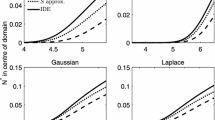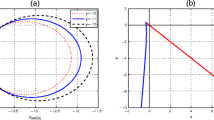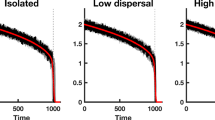Abstract
Statistical models using partial differential equations (PDEs) to describe dynamically evolving natural systems are appearing in the scientific literature with some regularity in recent years. Often such studies seek to characterize the dynamics of temporal or spatio-temporal phenomena such as invasive species, consumer-resource interactions, community evolution, and resource selection. Specifically, in the spatial setting, data are often available at varying spatial and temporal scales. Additionally, the necessary numerical integration of a PDE may be computationally infeasible over the spatial support of interest. We present an approach to impose computationally advantageous changes of support in statistical implementations of PDE models and demonstrate its utility through simulation using a form of PDE known as “ecological diffusion.” We also apply a statistical ecological diffusion model to a data set involving the spread of mountain pine beetle (Dendroctonus ponderosae) in Idaho, USA.
This article has supplementary material online.
Similar content being viewed by others
References
Aarts, G., Fieberg, J., and Matthiopoulos, J. (2012), “Comparative Interpretation of Count, Presence–Absence and Point Methods for Species Distribution Models,” Methods in Ecology and Evolution, 3, 177–187.
Alfaro, R., Campbell, R., Vera, P., Hawkes, B., and Shore, T. (2004), “Dendroecological Reconstruction of Mountain Pine Beetle Outbreaks in the Chilcotin Plateau of British Columbia,” in Mountain Pine Beetle Symposium: Challenges and Solutions, eds. T. L. Shore, J. E. Brooks, and J. E. Stone, pp. 245–256. Natural Resources Canada, Information Report BC-X-399.
Aukema, B. H., Carroll, A. L., Zhu, J., Raffa, K. F., Sickley, T. A., and Taylor, S. W. (2006), “Landscape Level Analysis of Mountain Pine Beetle in British Columbia, Canada: Spatiotemporal Development and Spatial Synchrony Within the Present Outbreak,” Ecography, 29, 427–441.
Aukema, B. H., Carroll, A. L., Zheng, Y., Zhu, J., Raffa, K. F., Moore, R. D., Stahl, K., and Taylor, S. W. (2008), “Movement of Outbreak Populations of Mountain Pine Beetle: Influences of Spatiotemporal Patterns and Climate,” Ecogeography, 31, 348–358.
Bentz, B. J. (2006), “Mountain Pine Beetle Population Sampling: Inferences from Lindgren Pheromone Traps and Tree Emergence Cages,” Canadian Journal of Forest Research, 36, 351–360.
Bentz, B. J., Logan, J. A., and Amman, G. D. (1991), “Temperature Dependent Development of the Mountain Pine Beetle (Coleoptera: Scolytidae), and Simulation of Its Phenology,” Canadian Entomologist, 123, 1083–1094.
Bentz, B. J., and Mullins, D. E. (1999), “Ecology of Mountain Pine Beetle (Coleoptera: Scolytidae) Cold Hardening in the Intermountain West,” Environmental Entomology, 28, 577–587.
Bentz, B. J., Powell, J. A., and Logan, J. A. (1996), “Localized Spatial and Temporal Attack Dynamics of the Mountain Pine Beetle (Dendroctonus Ponderosae) in Lodgepole Pine,” USDA/FS Research Paper INT-RP-494, December, 1996.
Bentz, B. J., Régnière, J., Fettig, C. J., Hansen, E. M., Hayes, J. L., Hicke, J. A., and Seybold, S. J. (2010), “Climate Change and Bark Beetles of the Western United States and Canada: Direct and Indirect Effects,” BioScience, 60, 427–613.
Berliner, L. M. (1996), “Hierarchical Bayesian Time-Series Models,” in Maximum Entropy and Bayesian Methods, Amsterdam: Kluwer Academic, pp. 15–22.
Biesinger, Z., Powell, J. A., Bentz, B. J., and Logan, J. A. (2000), “Direct and Indirect Parameterization of a Localized Model for the Mountain Pine Beetle Lodgepole Pine System,” Ecological Modelling, 129, 273–296.
Blackard, J. A., Finco, M. V., Helmer, E. H., Holden, G. R., Hoppus, M. L., Jacobs, D. M., Lister, A. J., Moisen, G. G., Nelson, M. D., Riemann, R., Ruefenacht, B., Salajanu, D., Weyermann, D. L., Winterberger, K. C., Brandeis, T. J., Czaplewski, R. L., McRoberts, R. E., Patterson, P. L., and Tycio, R. P. (2008), “Mapping U.S. Forest Biomass Using Nationwide Forest Inventory Data and Moderate Resolution Information,” Remote Sensing of Environment, 112, 1658–1677.
Boone, C. K., Aukema, B. H., Bohlmann, J., Carroll, A. L., and Raffa, K. F. (2011), “Efficacy of Tree Defense Physiology Varies with Bark Beetle Population Density: A Basis for Positive Feedback in Eruptive Species,” Canadian Journal of Forest Research, 41, 1174–1188.
Borden, J. H., Ryker, L. C., Chong, L. J., Pierce, H. D., Johnston, B. D., and Oehlschlage, A. C. (1987), “Response of the Mountain Pine Beetle, Dendroctonus Ponderosae, to Five Semiochemicals in British Columbia Lodgepole Pine Forests,” Canadian Journal of Forest Research, 17, 118–128.
Cangelosi, A. R., and Hooten, M. B. (2009), “Models for Bounded Systems with Continuous Dynamics,” Biometrics, 65, 850–856.
Crabb, B. A., Powell, J. A., and Bentz, B. J. (2012), “Development and Assessment of 30-m Pine Density Maps for Landscape-Level Modeling of Mountain Pine Beetle Dynamics,” Research Paper RMRS-RP-96WWW. Fort Collins, CO: U.S. Department Beetle Dynamics. Res. Pap. RMRS-RP-96WWW. Fort Collins, CO: U.S. Department of Agriculture, Forest Service, Rocky Mountain Research Station, p. 43.
Cressie, N. A. C., and Wikle, C. K. (2010), Statistics for Spatio-Temporal Data, Hoboken, NJ: Wiley.
Cressie, N. A. C., Calder, C. A., Clark, J. S., Ver Hoef, J. M., and Wikle, C. K. (2009), “Accounting for Uncertainty in Ecological Analysis: The Strengths and Limitations of Hierarchical Statistical Modeling,” Ecological Applications, 19, 553–570.
Crookston, N. L., Stark, R. W., and Adams, D. L. (1977), “Outbreaks of Mountain Pine Beetle in Northwestern Lodgepole Pine Forests—1945 to 1975,” Forest, Wildlife and Range Experiment Station Bulletin No. 22. University of Idaho, Moscow, p. 7.
Ferreira, M. A. R., and Lee, H. K. H. (2007), Multiscale Modeling, a Bayesian Perspective, New York: Springer.
Ferreira, M. A. R., Higdon, D., Lee, H. K. H., and West, M. (2006), “Multiscale and Hidden Resolution Time Series Models,” Bayesian Analysis, 1, 947–968.
Fisher, R. A. (1937), “The Wave of Advance of Advantageous Genes,” Annals of Eugenics, 7, 355–369.
Garlick, M. J., Powell, J. A., and Hooten, M. B. (2011), “Homogenization of Large-Scale Movement Models in Ecology,” Bulletin of Mathematical Biology, 73, 2088–2108.
Gilbert, E., Powell, J. A., Logan, J. A., and Bentz, B. J. (2004), “Comparison of Three Models Predicting Developmental Milestones Given Environmental and Individual Variation,” Bulletin of Mathematical Biology, 66, 1821–1850.
Gotway, C. A., and Young, L. J. (2002), “Combining Incompatible Spatial Data,” Journal of the American Statistical Association, 97, 632–648.
Halsey, R. (1998), Aerial Detection Survey Metadata for the Intermountain Region 4. U.S. Department of Agriculture Forest Service, Forest Health Protection.
Heavilin, J., and Powell, J. A. (2008), “A Novel Method for Fitting Spatio-Temporal Models to Data, with Applications to the Dynamics of Mountain Pine Beetle,” Natural Resource Modelling, 21, 489–524.
Heavilin, J., Powell, J. A., and Logan, J. A. (2007), “Development and Parameterization of a Model for Bark Beetle Disturbance in Lodgepole Forest,” in Plant Disturbance Ecology, eds. K. Miyanishi and E. Johnson, New York: Academic Press, pp. 527–553.
Higdon, D., Gattiker, J., Williams, B., and Rightley, M. (2008), “Computer Model Calibration Using High-Dimensional Output,” Journal of the American Statistical Association, 103, 570–583.
Holmes, M. H. (1995), Introduction to Perturbation Methods, New York: Springer.
Hooten, M. B., and Wikle, C. K. (2007), “Shifts in the Spatio-Temporal Growth Dynamics of Shortleaf Pine,” Environmental and Ecological Statistics, 14, 207–227.
— (2008), “A Hierarchical Bayesian Non-linear Spatio-Temporal Model for the Spread of Invasive Species with Application to the Eurasian Collared-Dove,” Environmental and Ecological Statistics, 15, 59–70.
Hooten, M. B., Leeds, W. B., Fiechter, J., and Wikle, C. K. (2011), “Assessing First-Order Emulator Inference for Physical Parameters in Nonlinear Mechanistic Models,” Journal of Agricultural, Biological, and Environmental Statistics, 16, 475–494.
Hotelling, H. (1927), “Differential Equations Subject to Error,” Journal of the American Statistical Association, 22, 283–314.
Hughes, R. R. (1973), “Dendroctonus: Production of Pheromones and Related Compounds in Response to Host Monoterpenes,” Zeitschrift für Angewandte Entomologie, 73, 294–312.
Lindgren, F., Rue, H., and Lindstrom, J. (2011), “An Explicit Link Between Gaussian Fields and Gaussian Markov Random Fields: The SPDE Approach (with Discussion),” Journal of the Royal Statistical Society. Series B, 73, 423–498.
Logan, J. A., and Powell, J. A. (2001), “Ghost Forests, Global Warming, and the Mountain Pine Beetle (Coleoptera: Scolytidae),” American Entomologist, 47 (3), 160–173.
Logan, J. A., White, P., Bentz, B. J., and Powell, J. A. (1998), “Model Analysis of Spatial Patterns in Mountain Pine Beetle Outbreaks,” Theoretical Population Biology, 53 (3), 236–255.
McCambridge, W. F. (1967), “Nature of Induced Attacks by the Black Hills Beetle, Dendroctonus Ponderosae (Coleoptera: Scolytidae),” Annals of the Entomological Society of America, 64, 534–535.
McGregor, M. D. (1978), “Status of Mountain Pine Beetle Glacier National Park and Glacier View Ranger District, Flathead National Forest, MT, 1977,” Forest Insect and Disease Management Report No. 78-6, Missoula, MT.
Mitchell, A. R., and Griffiths, D. F. (1980), The Finite Difference Method in Partial Differential Equations, New York: Wiley.
Mitchell, R. G., and Preisler, H. K. (1991), “Analysis of Spatial Patterns of Lodgepole Pine Attacked by Outbreak Populations of the Mountain Pine Beetle,” Forest Science, 37 (5), 1390–1408.
Murray, J. D. (2002), Mathematical Biology (3rd ed.), New York: Springer.
Okubo, A., and Levin, S. A. (2001), Diffusion and Ecological Problems: Modern Perspectives (2nd ed.), New York: Springer.
Pavliotis, G. A., and Stuart, A. M. (2008), Multiscale Methods: Averaging and Homogenization, New York: Springer.
Perkins, D. L., and Swetnam, T. W. (1996), “A Dendroecological Assessment of Whitebark Pine in the Sawtooth-Salmon River Region, Idaho,” Canadian Journal of Forest Research, 26, 2123–2133.
Pitman, G. B. (1971), “Trans-Verbenol and Alpha-Pinene: Their Utility in Manipulation of the Mountain Pine Beetle,” Journal of Economic Entomology, 64, 426–430.
Poole, D., and Raftery, A. E. (2000), “Inference for Deterministic Simulation Models: The Bayesian Melding Approach,” Journal of the American Statistical Association, 95, 1244–1255.
Powell, J. A., and Bentz, B. J. (2009), “Connecting Phenological Predictions with Population Growth Rates for Mountain Pine Beetle, an Outbreak Insect,” Landscape Ecology, 24, 657–672.
Powell, J. A., Logan, J. A., and Bentz, B. J. (1996), “Local Projections for a Global Model of Mountain Pine Beetle Attacks,” Journal of Theoretical Biology, 179 (3), 243–260.
R Development Core Team (2012), R: A Language and Environment for Statistical Computing, Vienna, Austria: R Foundation for Statistical Computing. ISBN 3-900051-07-0, URL http://www.R-project.org/
Raffa, K. F., Phillips, T. W., and Salom, S. M. (1993), “Strategies and Mechanisms of Host Colonization by Bark Beetles,” in Beetle-Pathogen Interactions in Conifer Forests, eds. T. D. Schowalter and G. M. Filip, New York: Academic Press, pp. 103–120.
Raffa, K. F., Aukema, B. H., Bentz, B. J., Carroll, A. L., Hicke, J. A., Turner, M. G., and Romme, W. H. (2008), “Cross-Scale Drivers of Natural Disturbances Prone to Anthropogenic Amplification: Dynamics of Biome-Wide Bark Beetle Eruptions,” BioScience, 58 (6), 501–518.
Régnierè, J., and Bentz, B. J. (2007), “Modeling Cold Tolerance in the Mountain Pine Beetle, Dendroctonus Ponderosae,” Journal of Insect Physiology, 53 (6), 559–572.
Risken, H. (1989), The Fokker-Planck Equation: Methods of Solution and Applications, New York: Springer.
Robertson, C., Nelson, T. A., and Boots, B. (2007), “Mountain Pine Beetle Dispersal: The Spatial-Temporal Interaction of Infestations,” Forestry Science, 53, 395–405.
Robertson, C., Nelson, T. A., Jelinski, D. E., Wulder, M. A., and Boots, B. (2009), “Spatial-Temporal Analysis of Species Range Expansion: The Case of the Mountain Pine Beetle, Dendroctonus Ponderosae,” Journal of Biogeography, 36 (8), 1446–1458.
Royle, J. A., and Wikle, C. K. (2005), “Efficient Statistical Mapping of Avian Count Data,” Environmental and Ecological Statistics, 12, 225–243.
Safranyik, L., Linton, D. A., Silversides, R., and McMullen, L. H. (1992), “Dispersal of Released Mountain Pine Beetles Under the Canopy of a Mature Lodgepole Pine Stand,” Journal of Applied Entomology, 113, 441–450.
Safranyik, L., Carroll, A. L., Régnière, J., Langor, D. W., Riel, W. G., Shore, T. L., Peter, B., Cooke, B. J., Nealis, V. G., and Taylor, S. W. (2010), “Potential for Range Expansion of Mountain Pine Beetle Into the Boreal Forest of North America,” The Canadian Entomologist, 142, 415–442.
Sambaraju, K. R., Carroll, A. L., Zhu, J., Stahl, K., Moore, R. D., and Aukema, B. H. (2012), “Climate Change Could Alter the Distribution of Mountain Pine Beetle Outbreaks in Western Canada,” Ecography, 35, 211–223.
Turchin, P. (1998), Quantitative Analysis of Movement, Sunderland, MA: Sinauer Associates, Inc. Publishers.
Warton, D. I., and Shepherd, L. C. (2010), “Poisson Point Process Models Solve the “Pseudo-absence Problem” for Presence-Only Data in Ecology,” The Annals of Applied Statistics, 4, 1383–1402.
Wikle, C. K. (2003), “Hierarchical Bayesian Models for Predicting the Spread of Ecological Processes,” Ecology, 84, 1382–1394.
— (2010), “Low-Rank Representations for Spatial Processes,” in Handbook of Spatial Statistics, eds. A. E. Gelfand, P. J. Diggle, M. Fuentes, and P. Guttorp, Boca Raton: CRC Press, pp. 107–118.
Wikle, C. K., and Berliner, L. M. (2005), “Combining Information Across Spatial Scales,” Technometrics, 47, 80–91.
Wikle, C. K., Berliner, L. M., and Milliff, R. F. (2003), “Hierarchical Bayesian Approach to Boundary Value Problems with Stochastic Boundary Conditions,” Monthly Weather Review, 131, 1051–1062.
Wikle, C. K., and Hooten, M. B. (2010), “A General Science-Based Framework for Nonlinear Spatio-Temporal Dynamical Models,” Test, 19, 417–451.
Wikle, C. K., Milliff, R. F., Nychka, D., and Berliner, L. M. (2001), “SpatioTemporal Hierarchical Bayesian Modeling: Tropical Ocean Surface Winds,” Journal of the American Statistical Association, 96, 382–397.
Zheng, Y., and Aukema, B. (2010), “Hierarchical Dynamic Modeling of Outbreaks of Mountain Pine Beetle Using Partial Differential Equations,” EnvironMetrics, 21, 801–816.
Author information
Authors and Affiliations
Corresponding author
Electronic Supplementary Material
Below is the link to the electronic supplementary material.
Rights and permissions
About this article
Cite this article
Hooten, M.B., Garlick, M.J. & Powell, J.A. Computationally Efficient Statistical Differential Equation Modeling Using Homogenization. JABES 18, 405–428 (2013). https://doi.org/10.1007/s13253-013-0147-9
Published:
Issue Date:
DOI: https://doi.org/10.1007/s13253-013-0147-9




